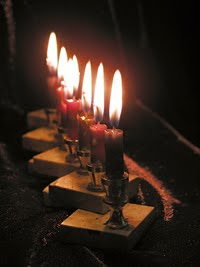בכל דור ודור חייב אדם לראות את עצמו כאילו
הוא יצא ממצרים. שנאמר והגדת לבנך ביום ההוא
לאמור בעבור זה עשה ה' לי בצאתי ממצרים
"In every generation, each person must feel as if he personally had come out of Mitzrayim (Egypt), as the Torah says: "You should tell your child on that day, 'When I left Mitzrayim, Hashem did miracles for me .....'" [The Pesach Haggadah]
THE SEDER PLATE
It is customary to use our most beautiful silver, dishes and tableware. At the head of the table, in front of the person leading the Seder is the Seder plate and a matza bag that holds the three matzot. Others use a Seder plate that looks like a three-tiered structure that holds three matzot with a place for 6 items on its roof.
The 6 items have special meanings.
1. Z'ro'a - A Roasted Bone (roasted chicken wing or shank bone) to remind us of the Pesach offerings that would be brought in the Bait Hamikdash (Holy Temple) in Yerushalayim (Jerusalem).
2. Beitzah - A Roasted Hardboiled Egg to remind us of our mourning at the destruction of the Bait Hamikdash, may it be rebuilt soon, in our lifetime.
3. Maror
4. Chazeret
Two types of bitter herbs (vegetables). We eat bitter herbs twice during the Seder.
1. once by themselves as MAROR
2. the second time with matzah as KORECH
Two kinds of bitter vegetables are placed on the Seder plate. Most people use romaine lettuce (whole leaves or the stalks) and raw horseradish (whole or grated). Either may be used for MAROR or KORECH.
5. Charoset - a mixture of ground apples, nuts, ginger, cinnamon, and red sweet wine. The look and feel of mortar symbolizes the bricks and mortar which we were forced to use when we were slaves in Egypt.
6. Karpas - A vegetable, other than marror, (most use boiled potato, celery or parsley), which is dipped into salt water and eaten.
To remind ourselves of the sweat and tears we shed as slaves, we place a bowl of the salt water near the Seder plate.
To continue reading go to:
http://www.breslev.co.il/articles/holidays_and_fast_days/pesach/the_seder_overview.aspx?id=1389&language=english
Signers Admit They Were Misled As Baalei Batim Letter Threatening Torah
Institutions Unravels
-
YWN was first to report that multiple signatures on a recent letter by
Baalei Batim threatening Gedolim and Mosdos Hatorah with funding was
riddled with ...
2 hours ago































No comments:
Post a Comment